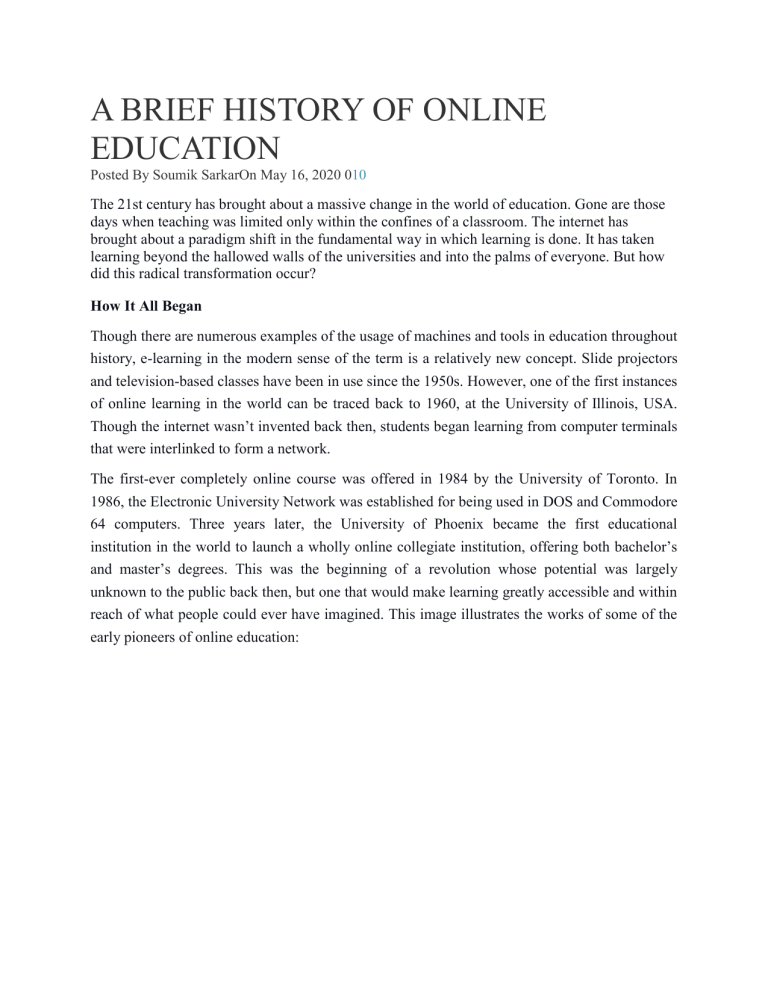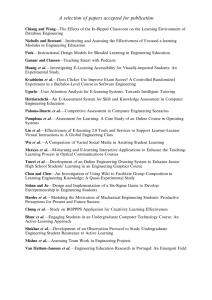
A BRIEF HISTORY OF ONLINE EDUCATION Posted By Soumik SarkarOn May 16, 2020 010 The 21st century has brought about a massive change in the world of education. Gone are those days when teaching was limited only within the confines of a classroom. The internet has brought about a paradigm shift in the fundamental way in which learning is done. It has taken learning beyond the hallowed walls of the universities and into the palms of everyone. But how did this radical transformation occur? How It All Began Though there are numerous examples of the usage of machines and tools in education throughout history, e-learning in the modern sense of the term is a relatively new concept. Slide projectors and television-based classes have been in use since the 1950s. However, one of the first instances of online learning in the world can be traced back to 1960, at the University of Illinois, USA. Though the internet wasn’t invented back then, students began learning from computer terminals that were interlinked to form a network. The first-ever completely online course was offered in 1984 by the University of Toronto. In 1986, the Electronic University Network was established for being used in DOS and Commodore 64 computers. Three years later, the University of Phoenix became the first educational institution in the world to launch a wholly online collegiate institution, offering both bachelor’s and master’s degrees. This was the beginning of a revolution whose potential was largely unknown to the public back then, but one that would make learning greatly accessible and within reach of what people could ever have imagined. This image illustrates the works of some of the early pioneers of online education: The Open University in Britain was one of the first universities in the world to begin online distance learning, in the early 1990s. Currently, the Indira Gandhi National Open University in India is the largest university in the world with around 4 million students enrolled, most of whom currently receive education via online methods. How Big is the Market Size? Online learning is booming in current times. Aided by the widespread availability of high-speed internet, making use of new technologies such as 4G and the soon-to-be-released 5G, online learning is expected to grow by leaps and bounds in the foreseeable future. The worldwide market size of online learning is approximately $187.87 billion in 2019, a 400% increase over what it was just six years ago. This phenomenal growth has been made possible not just by the rapidly evolving scenario in the world of technology, but also by the spread of education in the developing world. Experts predict that the next wave of online education will occur not in North America and Europe, but newly emerging markets like Africa, India, and China. Source: Technavio report Online learning is no longer just limited to colleges and universities. Right since primary school, online learning is gradually being incorporated into the curriculum. The recent COVID-19 pandemic further illustrates the importance of online learning in today’s school system, as it has proven to be a boon to both students and teachers alike who are unable to attend school due to the risk of disease spread. Beyond high school, online learning is steadily increasing its market share at the pre-university level. Furthermore, e-learning is expanding in presence beyond the traditional fields as well. Source: University Affairs Magazine Recent Developments in Online Learning Online learning has evolved far beyond its original capabilities. It is no longer limited to a didactic method, which had a one-way monologue from the teacher to the student. Current advances in online learning enable the student to play an active role in the learning process, with regular feedback and assessments. This has greatly improved the effectiveness of the teaching system, bringing it on par with classroom-based learning. Some of the features that give an edge to online education are: Less expensive than traditional teaching methods: As the cost of teaching is low, the expenses borne by the students inevitably come down. This makes education far more widespread and economical. Vast variety of available courses: These days, online courses on everything are available at the touch of a button – from religion to commerce, philosophy to fashion designing, programming to painting, photography to yoga – there is hardly any field that hasn’t been touched by e-learning. Study groups: There is a scope of engaging with like-minded students across the world, sharing information and ideas. Flexibility: This can be in terms of time, money, and location. Online learning enables the student and the teacher to be present at opposite ends of the world, in different time zones, and yet have the knowledge imparted effectively. Much less infrastructure required: This is a huge incentive to the education providers, as the additional costs are largely minimized. Standardized quality: Since the content available online can be evaluated and revised at any point in time, it helps maintain a reasonable standard of quality. Smartphones have played a crucial role in making online learning viable. It is rapidly gaining ground even in rural areas, bringing high-quality education, at par with the best in the world, available to the masses. Massive open online courses (known as MOOCs) are a promising new field. The New York Times had declared 2012 as “the year of the MOOC”, and there has been no stopping since then. The total number of students enrolled in MOOCs has risen to about 100 million now. Thus, the recent developments in online learning can be broadly attributed to the following factors: Innovation in smartphone technology High-speed data access Interactive learning models Rising number of startups in the e-learning field Source: Class Central Inc. The Future of Online Learning The global online learning market is projected to grow at a CAGR of 9.23% within the next five years, bringing the overall market share to $319 billion by 2025, increasing from $187.87 billion in 2019. This is an astounding amount that is full of potential. It is imperative for currently existing market players as well as new entrants to seize this opportunity and usher in a modern era in the field of education. The following factors are expected to play a central role in this rapidly ongoing transformation: The rise of AI (Artificial Intelligence) Cloud-based solutions Massive investments by major market players Use of VR (virtual reality) technology in education Growth of IoT (Internet of Things) To summarize, online learning is one of the most life-changing innovations of the present century. Education is perhaps the biggest asset of the modern era and online learning has provided a medium to disseminate it among the entire population. This presents a situation full of potential, which if properly harnessed, can catapult the entire world into a new dawn of development and prosperity.

